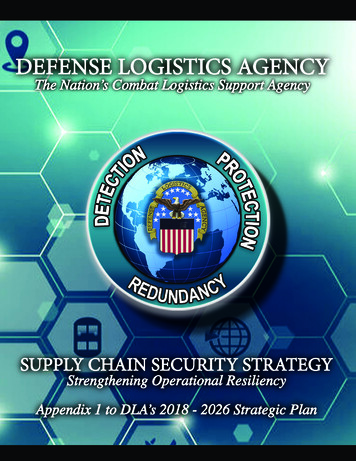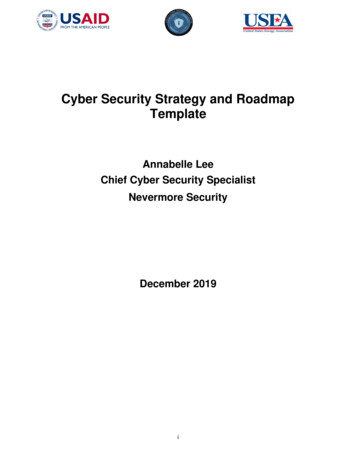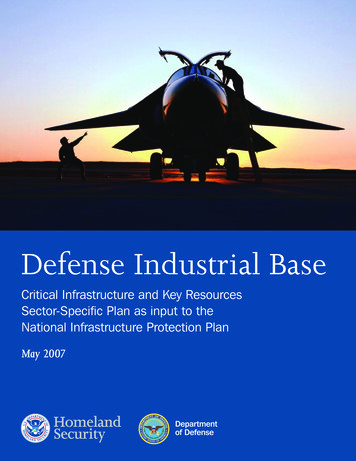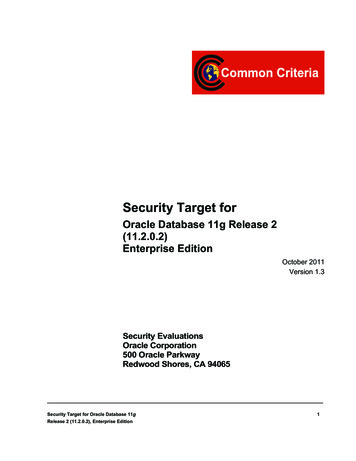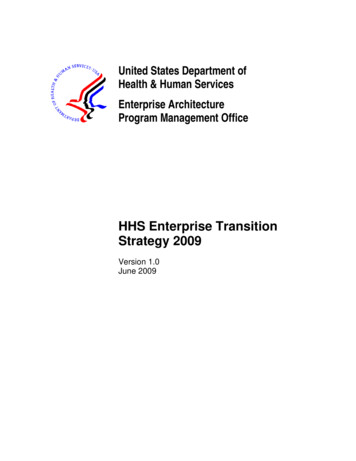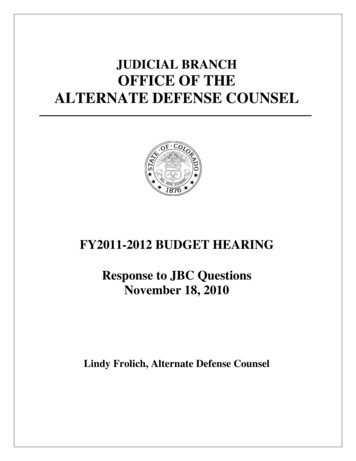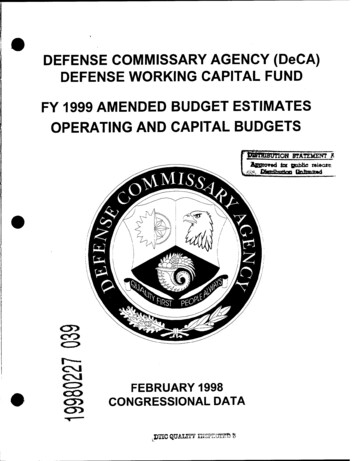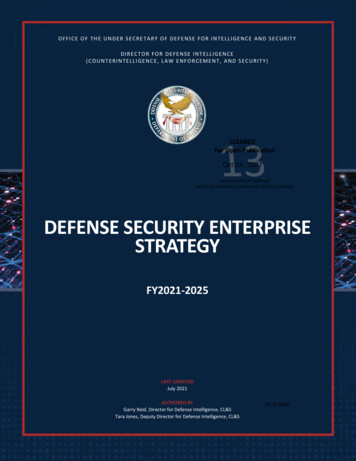
Transcription
OFFICE OF THE UNDER SECRETARY OF DEFENSE FOR INTELLIGENCE AND SECURITYDIRECTOR FOR DEFENSE INTELLIGENCE(COUNTERINTELLIGENCE, LAW ENFORCEMENT, AND SECURITY)CLEAREDFor Open PublicationOct 04, 2021Department of DefenseOFFICE OF PREPUBLICATION AND SECURITY REVIEWDEFENSE SECURITY ENTERPRISESTRATEGYFY2021-2025LAST UPDATEDJuly 2021AUTHORED BYGarry Reid, Director for Defense Intelligence, CL&STara Jones, Deputy Director for Defense Intelligence, CL&S22-S-00050DEFENSE SECURITY ENTERPRISE STRATEGY FY2021-2025
TABLE OF CONTENTSMessage from the Defense Security Executives . 3Executive Summary. 4DSE Overview . 5The Need for an Integrated Enterprise . 6DSE Vision 2025 . 8DSE Values . 9DSE Strategic Goals and Objectives . 10Goal 1: Elevate Defense Security across the Department, FederalGovernment, and Industry . 11Goal 2: Coordinate policies, processes, and operations across theEnterprise and among the security disciplines and security-relatedfunctions . 12Goal 3: Establish an integrated capability to anticipate andrespond to evolving threats with speed and innovation . 13Conclusion . 14Appendix A: DSE Governance . 15Appendix B: Definitions . 17
MESSAGE FROM THEDEFENSE SECURITY EXECUTIVESWe are pleased to present the Defense Security Enterprise (DSE) Strategy for Fiscal Years (FY)2021-2025. This strategy, developed collaboratively across the Enterprise, provides aframework for the DSE as we seek to elevate, integrate, and optimize Defense Security in aformidable threat environment.This Strategy outlines the goals and objectives for the Enterprise to pursue for a more cohesive,integrated, and future-focused security framework. Overcoming traditional silos and addressingcritical gaps more effectively will enable the Enterprise to capitalize on commonalities, identifysecurity gaps, and collaboratively develop solutions that improve the Nation’s security.As you familiarize yourself with the strategy, we hope you will share it with your leadership,partners, and stakeholders to foster dialogue and seek effective means of addressing theDepartment’s most pressing security needs. We hope this strategy serves to emphasize thenature of the threats facing the United States and solidify your commitment to facing thesechallenges in partnership. We look forward to continued collaboration as the Enterprisecoalesces around redefining and elevating security for the 21st century.Garry ReidDirectorfor Defense Intelligence, CL&STara JonesDeputy Directorfor Defense Intelligence, CL&S3DEFENSE SECURITY ENTERPRISE STRATEGY FY2021-2025
EXECUTIVE SUMMARYThe United States faces an unprecedented threat environment as asymmetric, non-kineticwarfare increasingly threatens critical infrastructure, undermines democratic institutions, anderodes U.S. military readiness and competitive advantage. To defend freedom, preserveeconomic prosperity, and maintain global stability, the Department must have an effective,efficient, and forward-looking Defense Security Enterprise (DSE).Since the release of the 2013 DSE Strategy, the threat environment has evolved and becomemore complex; a robust security architecture has never been more essential to theDepartment’s success. Strategic competitors increasingly disrupt the patterns of traditionalwarfare and endanger global stability in the process. As new technological capabilitiesembolden U.S. adversaries, the DSE must not only keep pace but anticipate new vulnerabilitiesand avenues of attack. Such vulnerabilities and targets may range from emerging technologies,growing reliance on the Internet of Things, dual-use intellectual property, a diffuse global supplychain, the uncleared industrial base, and controlled unclassified information.In the face of evolving challenges, the DSE must establish and implement a robust securityframework to enable cooperation and collaboration across the Enterprise. The DSE mustimprove and elevate the security culture within the Department and posture to maintainstrategic and operational dominance against dynamic threats. To succeed, the DSE mustreassess and re-engineer its methods, embrace innovation, and work with the U.S. interagency,the national security innovation base (NSIB), and allied and partner nations to effectivelyelevate security. The DSE will engage its partners and peers to better understand gaps in theexisting security framework and the interdependencies of security-related functions. The DSEwill strive to re-create or modify existing methods, better coordinate security practices amongits stakeholders, increase awareness and understanding of Defense Security, share informationeffectively and efficiently, and define measures for success.The FY2021-2025 DSE Strategy provides a course of action for the Department to elevate,integrate, and optimize Defense security. By implementing this strategy, the DSE will betteralign security resources across the Enterprise, enhance integration and standardization, andoptimize our ability to anticipate threats and vulnerabilities. With a more robust securityframework, the Department will be better equipped to combat the complex, diverse, andharmful range of threats to U.S. interests and assets.DEFENSE SECURITY ENTERPRISE STRATEGY FY2021-20254
DSE OVERVIEWThe DSE is a community with the shared mission to safeguard Department personnel,information, and property against harm, loss, misuse, or hostile acts and influences in supportof national security. 1The Enterprise is comprised of stakeholders from across the Department and seeks tocollaborate with other enterprise and national security efforts to include the intelligencecommunity (IC) and the national security innovation base. The DSE formally convenesstakeholders through senior-level governance and leadership forums, such as the DSE EXCOMand DSEAG (see Appendix A for the full list of responsibilities for each body). Through theseforums, the DSE will collaborate to achieve its vision and strategy, provide direction andsolutions on issues that impact the Enterprise, measure progress toward DSE goals, and removebarriers for the good of all Enterprise stakeholders. Through integrated plans, infrastructure,and measures, the DSE EXCOM and the DSEAG will ensure a unified Defense securityframework, a robust Defense Security strategy, and a comprehensive arsenal of policies toimprove risk management and codify systems that safeguard Departmental resources.1DoD Directive 5200.43, “Management of the Defense Security Enterprise,” July 14, 2020, as amended.*Designated DoD Components to include any Components invited to participate on EXCOM meetings bythe Defense Security Executive.DEFENSE SECURITY ENTERPRISE STRATEGY FY2021-20255
THE NEED FOR AN INTEGRATED ENTERPRISEThe current threat environment challenges the United States’ ability to secure its workforce,operations, and position as a world leader. U.S. strategic and operational dominance hasalready deteriorated against a backdrop of adversarial threats of increasing speed and scope.The DSE must assess and quantify evolving security threats, reduce misalignment of effortacross the Enterprise, integrate security and security-related functions, and influencedepartmental stakeholders to elevate security to overcome this formidable environment.The Enterprise must work together to increase awareness of critical national security threats toinform risk management and reduction. Some of the most prominent threats to nationalsecurity include:ASYMMETRIC WARFARE FROM STRATEGICCOMPETITORSModernized and aggressive adversarial regimes increasinglychallenge the international order and stability of democraticnations. The United States must anticipate and combat newmethods of warfare and bolster partnerships with allied andpartner nations to mitigate attacks on U.S. economic andpolitical institutions. The Enterprise must posture the UnitedStates to protect a growing set of vulnerabilities, especiallywithin the supply chain and NSIB. Through increasedcooperation and understanding, the Enterprise can remainvigilant against evolving and formidable adversarial threats.TERRORISM AND INSIDER THREATSThe Department faces multi-faceted challenges from terrorists,self-radicalized lone actors, domestic extremists, activeshooters, and malicious insiders. They continue to misusegovernment information, target Department personnel andoperations, and cause irreparable damage to critical assets. Asthreats evolve in nature and scale, the potential costs tonational security are magnified. The Department must remainvigilant and educate its workforce on current and real threats,especially as military members are increasingly targeted bydomestic terrorist groups due to their credibility and skill sets.The DSE must change the narrative surrounding the evolutionof terrorists and insider threats, raise awareness aroundbehavioral indicators, and increase reporting throughinterconnected tactics and solutions.DEFENSE SECURITY ENTERPRISE STRATEGY FY2021-20256
TECHNOLOGICAL ADVANCEMENTSTechnological advancements in fields including informationcommunications technology (ICT); artificial intelligence biotechnology; and quantum computing create growingconcerns for the protection of critical Department assets andinformation. As adversaries utilize new capabilities, the rangeof potential targets has increased, from mobile devices andintellectual property to weapons systems and democraticelections. The Department must keep pace with new systemdevelopment to replace outdated and inferior systems. Thegrowing vulnerability of U.S. critical technology andinformation systems must be central to the Enterprise’sstrategic operations and planning.Regardless of the formidable threat environment, the United States has a unique opportunityto evolve and build the infrastructure required to maintain dominance and outmaneuver itsenemies. Through collaboration, the Enterprise can improve its ability to assess the risks thatpose the greatest threats to national security and prioritize resources based on those risks.Through leadership and well-executed governance, the DSE can enable world-class securityapproaches and modernize its workforce, processes, and policies. The DSE can create newunique and cutting-edge capabilities through partnerships with other federal agencies,government and academic research laboratories, industrial base partners, and allied andpartner nations. Integrated partnerships will enable the Department to leverage additionalresources and better combat current and future adversarial threats.This DSE Strategy outlines the goals and objectives that will enable the DSE to: (1) reconceptualize and prioritize security (elevate); (2) strengthen relationships and cohesion acrossthe Department, the NSIB, the U.S. interagency, and with allied and partner nations (integrate);and (3) establish the infrastructure and leadership necessary to prioritize and leverage cuttingedge solutions to emerging threats (optimize). As a unified Enterprise, the DSE has theopportunity to strengthen security and shore up democratic and economic prosperity.DEFENSE SECURITY ENTERPRISE STRATEGY FY2021-20257
DSE VISION 2025Through collaboration and coordination, the DSE will develop a more robust and integratedsecurity infrastructure to strengthen national security by ensuring the resilience of its programs,protecting people, and safeguarding information.In summer 2020, DSE stakeholders came together to create a shared vision of the DefenseSecurity future state. As a result of these discussions, the DSE EXCOM committed to thefollowing vision for the DSE in 2025:DEFENSE SECURITY ENTERPRISE STRATEGY FY2021-20258
DSE VALUESDSE stakeholders identified the following values to guide the decisions and actions of theEnterprise as it develops and implements rigorous strategies, disciplined leadership, intentionalmission management, and deliberate education.MAINTAIN WARFIGHTING ADVANTAGEWe protect defense information, personnel, resources, and critical infrastructureand promote warfighting advantage solutions to enable the Department’s mission.LEAD WHAT’S NEXTWe generate forward-thinking solutions to stay ahead of competition andtechnological advancements and anticipate evolving threats.RISK-BASED VARIATION, UNCOMPROMISED RESULTSWe apply consistent standards to our security policies and practices but provideroom for variability within logic and reason.EMBRACE A WHOLE-OF-GOVERNMENT APPROACHWe unify behind common goals and an integrated joint-warfare mentality topromote effective information sharing and maximize the benefits of collectiveintelligence.DEMONSTRATE ACCOUNTABILITY AND TRUSTWe improve mission execution through transparent decision-making, cleardivisions of responsibility, and instilled connectivity and dialogue throughout thepolicy-making process.DEFENSE SECURITY ENTERPRISE STRATEGY FY2021-20259
DSE STRATEGIC GOALS AND OBJECTIVESThe DSE EXCOM developed three overarching goals with specific objectives to address theevolving threat environment. The EXCOM’s goals and objectives guide the Enterprise tostrengthen the Department’s security posture and achieve the DSE vision. These goals andobjectives will remain consistent throughout the duration of the DSE Strategy’s lifecycle;however, DSE leadership shall revisit the initiatives used to accomplish these goals andobjectives on an annual basis.DEFENSE SECURITY ENTERPRISE STRATEGY FY2021-202510
GOAL 1: ELEVATE DEFENSE SECURITY ACROSS THE DEPARTMENT,FEDERAL GOVERNMENT, AND INDUSTRYThe DSE partners with stakeholder organizations in the Department, the Federal Government,and the commercial sector to protect critical assets. To do this most effectively, stakeholdersmust share a common understanding about the critical role security plays in 21st centurywarfare, so that the Enterprise prioritizes actions necessary to secure the Department. The DSEwill convey the importance of security through effective communication via targeted messagingand collaboration with its partners. Objective 1.1. Empower and professionalize the security workforce to execute itsmission through enhanced and standardized security education, training, andcredentialingDSE security workforce represent the front line of the Department’s security mission. Toensure security professionals are best equipped to execute their mission, leadership mustensure their understanding of the security mission’s interconnectivities and strengthentheir ability to communicate how each respective discipline impacts the national securitymission. The Enterprise must empower its workforce through professionalization,education, and certification programs. By equipping and training those on the front lines toeffectively implement the security mission, the DSE will realize a more secure Departmentand consequently elevate security within the U.S. Government and across partnerships. Objective 1.2. Expand the perimeter of security beyond cleared industry to externalpartners in the uncleared defense industrial base and NSIBThe range of U.S. critical assets vulnerable to adversarial threats has greatly expanded,endangering the security of the national supply chain and industrial base. Today, securityrisks arise early in the industrial supply chain, subjecting our research and intellectualproperty to potential exploitation by near-peer competitors. The DSE seeks to betterprotect its operations by broadening its security purview beyond the current DIB touncleared industry and expanding partnership within the NSIB to educate industrystakeholders on growing security vulnerabilities. This expanded focus will increaseawareness of the importance of security and its impact on the United States and onindustry’s financial and security health. Objective 1.3. Influence stakeholders across the Enterprise to prioritize security indecision-makingThe renaming of the Under Secretary of Defense for Intelligence to the Under Secretary ofDefense for Intelligence and Security (USD(I&S)) was the first step toward increasing theprominence of the security mission across the Department. As leaders of the Enterprise, itis the EXCOM’s responsibility to carry out this mission with excellence by driving security asa central tenet in Department decision-making, rather than as an afterthought. Throughstakeholder engagement and communication, the DSE EXCOM will promote the importanceof security to Defense leadership and Components and to federal organizations. Suchefforts will help to ensure security credibility through increased transparency andDEFENSE SECURITY ENTERPRISE STRATEGY FY2021-202511
accountability, ensuring policies are properly planned and programmed so that policyissuances are executable as written and security priorities are understood and pursued.GOAL 2: COORDINATE POLICIES, PROCESSES, AND OPERATIONS ACROSSTHE ENTERPRISE AND AMONG THE SECURITY DISCIPLINES ANDSECURITY-RELATED FUNCTIONSEnterprise stakeholders and partners must work together to reduce misalignment and wastedresources that hinder progress toward elevating security. To strengthen and standardize crossenterprise coordination, the DSE must implement a Defense Security framework to clarify andarticulate how security and security-related functions must work together. This framework willenable a consistent and integrated approach to security management and execution. Together,the Enterprise can accelerate the distribution of critical intelligence and facilitate rapidmultilateral risk awareness and assessment. Objective 2.1. Standardize coordination among security disciplines and security-relatedfunctionsThe DSE will lead stakeholder organizations to create a cross-functional culture, solveproblems beyond conventional means, and equip subject matter experts across the securitydisciplines. Today’s collaborative pathways between security disciplines and securityrelated functions—including acquisition security, critical technology protection,counterintelligence, law enforcement, foreign disclosure, security cooperation, technologytransfer, export control, nuclear physical security, chemical and biological agent security,antiterrorism, and mission assurance policy—can be improved to reduce misalignment andsilos. The DSE must leverage relationships with security-related functions and clarifyexpectations for working together. The DSE will establish a cross-discipline framework tocommunicate expectations for collaboration, provide recommended processes for crossdiscipline security professionals, and establish a common security lexicon from which towork. Objective 2.2. Manage and centralize security information collection, reporting, analysis,and disseminationToday’s information-sharing systems can be improved to enable real-time analysis anddissemination, enable metric-driven decision-making, and reduce duplicative spending,collection, and reporting. The DSE will help stakeholder organizations more effectively linkinformation and data sources from across the Enterprise through a series of centralizedsystems. This will enable Enterprise partners to build on one another’s knowledge andsecurity information, working toward solutions together rather than across the divide ofoutdated systems and processes.DEFENSE SECURITY ENTERPRISE STRATEGY FY2021-202512
Objective 2.3. Enable and facilitate the build-up of the Defense Counterintelligence andSecurity Agency’s (DCSA) operational capabilities across all security domainsThe DSE will assist DCSA to define, shape, and make progress towards the future state of DCSAto effectively execute security operations in an integrated fashion. Then, the DSE will supportDCSA as necessary to achieve the DCSA mission as stated in EO 13969, and as established inthe DCSA Charter, to manage security programs, conduct security operations, and integratethe security community to increase its effectiveness. Through the DSEAG and EXCOM bodies,DCSA and the DSE will work together to assess critical challenges facing the Enterprise andidentify solutions so that DCSA may achieve progress towards its full operational capabilities.GOAL 3: ESTABLISH AN INTEGRATED CAPABILITY TO ANTICIPATE ANDRESPOND TO EVOLVING THREATS WITH SPEED AND INNOVATIONU.S. security infrastructure has deteriorated under the pressure of rising 21st century adversarialthreats and competing national security requirements. The Enterprise must adapt and bolster itscapabilities to swiftly develop and deliver new concepts, maintain a strategic and operationaladvantage, out-perform adversaries, and meet 21st century threats and information requirementswith 21st century solutions. Objective 3.1. Collect, assess, and prioritize fiscal priorities for the Enterprise to betteranticipate annual budget cyclesThe DSE faces a growing challenge to deliver at the speed of relevance while facing budgetconstraints. In the current fiscal environment, the Enterprise must embrace a proactiveapproach to budgetary planning and conduct due diligence on potential and existing securityprograms. This will ensure that new requirements are appropriately planned and programmedthrough the Planning, Programming, Budgeting and Execution (PPBE) process and ProgramObjective Memorandum (POM) cycle so policies and issuances are executable. By identifyingand prioritizing no-fail initiatives, the Enterprise will improve its ability to anticipate andrespond to evolving threats with speed and innovation despite a limited budget. Objective 3.2. Utilize governance processes to oversee and manage the implementation ofthe DSE StrategyThe role of the DSE EXCOM and DSEAG is to oversee and manage the implementation of theDefense Security Strategy. To effectively oversee and manage the Strategy, DSE leadershipmust be able to track and measure progress. This requires follow-through of critical Enterprisewide initiatives and assessments of performance measures and gaps. If the Enterprise is tosucceed, it must define, collect, and assess key performance indicators (KPIs) that measureprogress and performance toward outcomes. DSE leadership has designed a revisedgovernance structure (see Appendix A) and will establish and implement the governanceprocesses to achieve these objectives. This governance will drive progress toward anintegrated capability across the Enterprise.DEFENSE SECURITY ENTERPRISE STRATEGY FY2021-202513
Objective 3.3. Conduct scientific research to identify and leverage innovative approaches tosecurity programs and processesThe DSE must leverage research opportunities to innovate and integrate its currentprocesses and systems, collaborating with cutting-edge institutions and industry partnersto capitalize on U.S. technological advances and stay ahead of adversarial competition.This will increase the DSE’s ability to remain future-focused and flexible in the face ofevolving threats. The Advanced Research Lab for Intelligence and Security (ARLIS) is acritical research partner that will inform current and future approaches to integratedsecurity programs and processes.CONCLUSIONDSE leadership, in collaboration with the Enterprise, developed the FY2021-2025 DSE Strategyto provide an actionable plan for the Department to elevate, integrate, and optimize securityto position the nation for continued prosperity and military dominance. This effort willstrengthen strategic and operational alignment, reduce misalignment and silos, and enhancecapabilities to build a more robust security infrastructure. The Department and the Nation’sstrategic advantage depends on the success of the DSE. This Strategy is a commitment tostrengthened resolve across the Enterprise to anticipate and mitigate evolving threats, promotethe security mission across the U.S. Government, and ensure American resilience.DEFENSE SECURITY ENTERPRISE STRATEGY FY2021-202514
APPENDIX A: DSE GOVERNANCEDEFENSE SECURITY ENTERPRISE EXECUTIVE COMMITTEE (DSE EXCOM)The DSE EXCOM is the senior-level forum comprised of Tier-3 civilian executives or three-starGO/FO directors or equivalent representatives from the Military Departments, selectDepartment Components, and Fourth Estate organizations. The EXCOM collaborates acrosstraditional organizational boundaries to establish and measure DSE strategic direction andprovide cross-discipline perspectives to strengthen the Defense security posture. The primaryresponsibilities of the DSE EXCOM include:LeadThe EXCOM sets the strategic direction for Enterprise-wide security policy and high-impactsecurity decisions. It approves and updates the DSE vision, responding to the changing threatenvironment, and approves the DSE Strategy to achieve the vision. Along the way, the EXCOMidentifies and removes barriers to success.AdviseThe EXCOM assesses, prioritizes, and endorses critical DSE decisions and initiatives. It utilizesthe DSEAG to conduct due diligence on priority initiatives through working groups, thenevaluates the working groups’ findings. After thorough assessment, the EXCOM agrees tocourse corrections for priority initiatives.OverseeThe EXCOM identifies, monitors, and refines KPIs to measure and monitor progress against theDSE Strategy. It assesses performance to focus on gaps or underperforming areas and toevaluate the effectiveness of critical Enterprise initiatives.DEFENSE SECURITY ENTERPRISE ADVISORY GROUP (DSEAG)The DSEAG is the operational arm of the DSE, comprised of Tier-2 civilian executives or two-starGO/FO deputy directors or equivalent representatives from the Military Departments and selectDepartment Components, as well as Fourth Estate organizations. The DSEAG assesses theobjectives, risks, and pressing issues facing the Enterprise to make recommendations andescalate decisions to the EXCOM. The primary responsibilities of the DSEAG include:Collect & QualifyThe DSEAG surfaces and prioritizes critical initiatives from Components’ security organizationsto elevate to the EXCOM. These initiatives must have a direct impact on DSE memberorganizations, relate to DSE strategic goals, require cross-enterprise perspectives, and/orrequire further assessment and oversight to enable success. Once an initiative is identified andprioritized, the DSEAG conducts a rapid assessment or launches a working group to preparerecommendations on a path forward.DEFENSE SECURITY ENTERPRISE STRATEGY FY2021-202515
ManageAs the standing support body to the EXCOM, the DSEAG escalates decisions, prepares briefs,and documents EXCOM decisions and recommendations. The DSEAG is the coordinating bodyfor security program reviews and prioritizes and deconflicts resources for the securitycommunity to ensure an integrated and mutually reinforcing Enterprise. The DSEAG also staffs,launches, and oversees DSE working groups, providing a consistent approach and set of bestpractices. The DSEAG leverages working groups as finite entities that work to solve a specificproblem for a pre-determined amount of time. It evaluates working group assessments andfindings before preparing EXCOM members for decisions.Analyze & ReportThe DSEAG consolidates and analyzes KPI data across the Enterprise to determine whetherthere are shortfalls in a program’s implementation. The DSEAG also briefs the EXCOM onsecurity performance measures and identifies critical gaps for EXCOM evaluation and decision.DEFENSE SECURITY ENTERPRISE STRATEGY FY2021-202516
APPENDIX B: DEFINITIONSDefense Security Enterprise (DSE): The organizations, infrastructure, and measures (to includepolicies, processes, procedures, and products) in place to safeguard Department personnel,property, information, and mission against harm, loss, or hostile acts and influences. This systemof systems comprises cyber, industrial, information, personnel, physical, and operationssecurity, as well as SAP security policy, critical technology protection, counter insider threat,critical program information protection policy, security professionalization, and securitytraining. It addresses, as part of information security, classified information (including sensitivecompartmented information and Atomic Energy Act information) and controlled unclassifiedinformation. The DSE aligns to counterintelligence, law enforcement, foreign disclosure, securitycooperation, technology transfer, export control, nuclear physical security, chemical andbiological agent security, antiterrorism, acquisition security, and mission assurance policy. DSEpolicy is informed by other security-related efforts.Defense Security framework: The structure or architecture behind the relationships andinteractions of security disciplines.Industrial security: A multi-disciplinary security program concerned with the protection ofclassified information developed by or entrusted to U.S. industry.Information security: The system of policies, procedures, and requirements established inaccordance with EO 13526 to protect information that, if subjected to unauthorized disclosure,could reasonably be expected to cause damage to national security. The term also applies topolicies, procedures, and requirements established to protect unclassified information that maybe withheld from release to the public pursuant to Executive order, statute, or regula
DEFENSE SECURITY ENTERPRISE STRATEGY FY2021-2025 4 EXECUTIVE SUMMARY The United States n unprecedentedfaces a threat environment as asymmetric, non-kinetic . more complex; a robust security architecture has never been more essential to the Department's success. Strategic competitors increasingly disrupt the patterns of traditional
